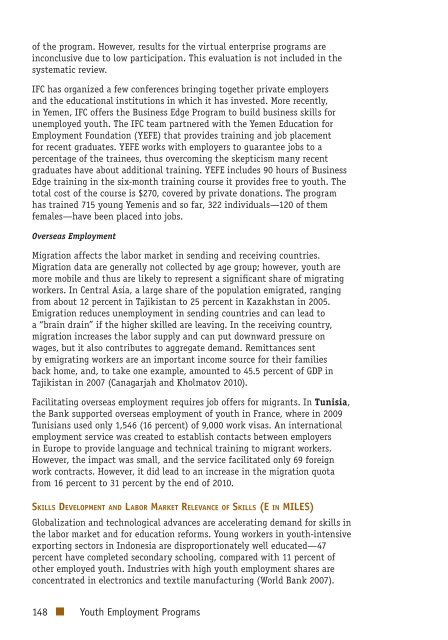Youth Employment Programs - Independent Evaluation Group
Youth Employment Programs - Independent Evaluation Group
Youth Employment Programs - Independent Evaluation Group
You also want an ePaper? Increase the reach of your titles
YUMPU automatically turns print PDFs into web optimized ePapers that Google loves.
of the program. However, results for the virtual enterprise programs areinconclusive due to low participation. This evaluation is not included in thesystematic review.IFC has organized a few conferences bringing together private employersand the educational institutions in which it has invested. More recently,in Yemen, IFC offers the Business Edge Program to build business skills forunemployed youth. The IFC team partnered with the Yemen Education for<strong>Employment</strong> Foundation (YEFE) that provides training and job placementfor recent graduates. YEFE works with employers to guarantee jobs to apercentage of the trainees, thus overcoming the skepticism many recentgraduates have about additional training. YEFE includes 90 hours of BusinessEdge training in the six-month training course it provides free to youth. Thetotal cost of the course is $270, covered by private donations. The programhas trained 715 young Yemenis and so far, 322 individuals—120 of themfemales—have been placed into jobs.Overseas <strong>Employment</strong>Migration affects the labor market in sending and receiving countries.Migration data are generally not collected by age group; however, youth aremore mobile and thus are likely to represent a significant share of migratingworkers. In Central Asia, a large share of the population emigrated, rangingfrom about 12 percent in Tajikistan to 25 percent in Kazakhstan in 2005.Emigration reduces unemployment in sending countries and can lead toa “brain drain” if the higher skilled are leaving. In the receiving country,migration increases the labor supply and can put downward pressure onwages, but it also contributes to aggregate demand. Remittances sentby emigrating workers are an important income source for their familiesback home, and, to take one example, amounted to 45.5 percent of GDP inTajikistan in 2007 (Canagarjah and Kholmatov 2010).Facilitating overseas employment requires job offers for migrants. In Tunisia,the Bank supported overseas employment of youth in France, where in 2009Tunisians used only 1,546 (16 percent) of 9,000 work visas. An internationalemployment service was created to establish contacts between employersin Europe to provide language and technical training to migrant workers.However, the impact was small, and the service facilitated only 69 foreignwork contracts. However, it did lead to an increase in the migration quotafrom 16 percent to 31 percent by the end of 2010.Skills Development and Labor Market Relevance of Skills (E in MILES)Globalization and technological advances are accelerating demand for skills inthe labor market and for education reforms. Young workers in youth-intensiveexporting sectors in Indonesia are disproportionately well educated—47percent have completed secondary schooling, compared with 11 percent ofother employed youth. Industries with high youth employment shares areconcentrated in electronics and textile manufacturing (World Bank 2007).148 <strong>Youth</strong> <strong>Employment</strong> <strong>Programs</strong>
















